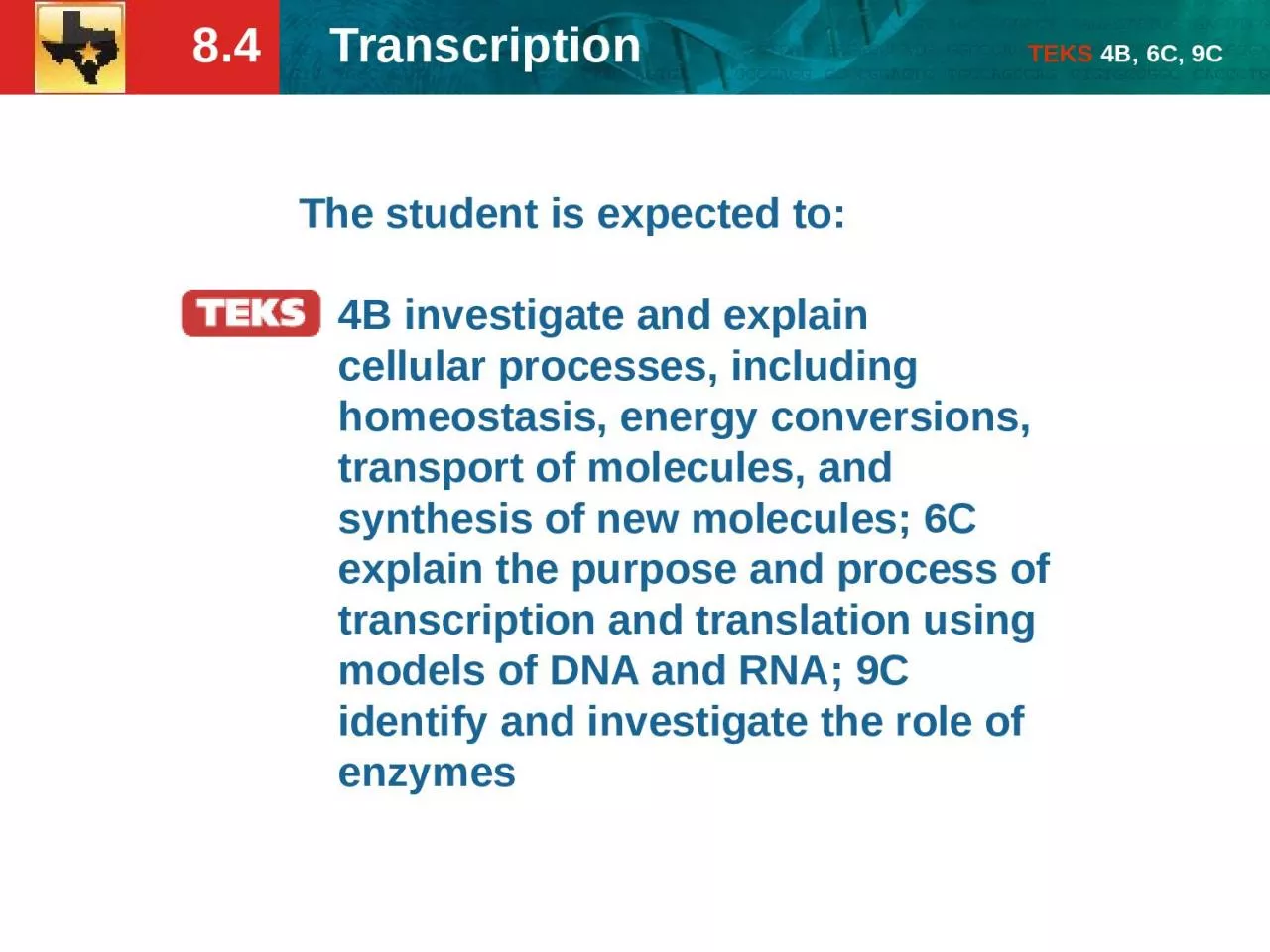

4B investigate and explain cellular processes including homeostasis energy conversions transport of molecules and synthesis of new molecules 6C explain the purpose and process of transcription and translation using models of DNA and RNA 9C identify and investigate the role of ID: 1044477
Download Presentation The PPT/PDF document "The student is expected to:" is the property of its rightful owner. Permission is granted to download and print the materials on this web site for personal, non-commercial use only, and to display it on your personal computer provided you do not modify the materials and that you retain all copyright notices contained in the materials. By downloading content from our website, you accept the terms of this agreement.
1. The student is expected to:4B investigate and explaincellular processes, including homeostasis, energy conversions, transport of molecules, and synthesis of new molecules; 6C explain the purpose and process of transcription and translation using models of DNA and RNA; 9C identify and investigate the role ofenzymes
2. What is a gene?A gene is a set of DNA instructions that control the synthesis of proteins within the cell. This process, called protein synthesis, involves 2 steps: transcription and translation.
3. RNA carries DNA’s instructions. The central dogma states that information flows in one direction from DNA to RNA to proteins.
4. The central dogma includes three processes.RNA is a link between DNA and proteins.replicationtranscriptiontranslation Replication Transcription Translation
5. Central Dogma of Molecular BiologyDNA cannot leave the nucleus, so a copy is made in the form of a similar nucleic acid called RNA (ribonucleic acid) during transcription. After DNA is used to make RNA, the RNA is then used to make proteins during translation by ribosomes in the cytoplasm.
6. How is DNA different from RNA?RNA contains the sugar ribose and DNA contains the sugar deoxyriboseRNA is single-stranded, DNA is double-stranded
7. RNA has uracil instead of thymine..
8. RNA contains uracil instead of thymine. Uracil, like thymine, is a pyrimidine (contains one ring).RNA is similar to DNA:RNA and DNA are both a nucleic acid macromolecule. RNA is made of nucleotides.Both DNA and RNA have adenine, cytosine, and guanine.How is DNA different from RNA?
9. Three types of RNAmessenger RNA (mRNA): carries a copy of the information in DNA.This type of RNA acts as a “messenger” bringing the information in the DNA to the ribosome.
10. ribosomal RNA (rRNA):Found within ribosomes. ( Recall that ribosomes synthesize proteins.) Ribosomes are made of both proteins and rRNA.2 subunits
11. 3. transfer RNA (tRNA): Brings amino acids to the ribosome to be added to the polypeptide chain that is being made at the ribosome. There is one tRNA for each of the 20 amino acids.Label this figure on your notes!Transfer RNAanticodontRNAAmino acid
12. Transcription-Click on the picture for video
13. Transcription(In the nucleus)Transcription is the process in which the nucleotide sequence of DNA is copied, within the nucleus, into a complementary nucleotide sequence of RNA. DNA mRNA
14. TranscriptionStep 1: The enzyme RNA polymerase binds to the DNA and separates the 2 DNA strands. Step 2: RNA polymerase uses only one strand of DNA as a template to make a complementary RNA strand. RNA Polymerase reads 3’ 5’
15. DNA is like the “master plan” and mRNA is like the “blueprint.” The master plan stays in the office (the nucleus) and the blueprint can be taken to the construction site (the ribosome).
16. Step 3RNApolymeraseDNARNAHow does RNA look different than DNA?Do RNA and DNA leave the nucleus?Once RNA is made, the RNA detaches from the template strand, leaves the nucleus through nuclear pores, and enters the cytoplasm of the cell and fo to a ribosome
17. Cells have the ability to control what genes are expressed and how often they need to be transcribed. Cells will cut out pieces from the mRNA that they do not wish to use or add promoters before a particular gene so it is transcribed more often.
18.
19. Practice with TranscriptionIf this is the given DNA strand: ATGCGATCGAGCGAAWrite out the complementary mRNA strand made during transcriptionUACGCUAGCUCGCUU